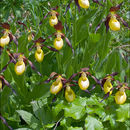Biology
(
anglais
)
fourni par Arkive
Thought to be one of the slowest-growing plants in the world, the lady's slipper orchid takes between 6 and 11 years of growth before it actually produces flowers (10). The seeds are minute, dust-like particles that contain no food reserves. The materials needed for germination are derived from a symbiotic association with a mycorrhizal fungus. Orchids can be difficult to propagate in artificial conditions for this reason, but the lady's slipper orchid has been studied and successful ex-situ propagation techniques have been devised (7). It is dormant in winter, does not form tubers, but has creeping rhizomes (12).
Conservation
(
anglais
)
fourni par Arkive
This orchid has been targeted by a successful Species Recovery Programme since 1982 (run by English Nature since 1992) and is a priority species under the UK Biodiversity Action Plan (BAP) (1). The remaining native population is carefully managed, and has benefited from wardening, suitable habitat management and the re-introduction of ex-situ propagated plants (1). The Sainsbury Orchid Project at the Royal Botanic Gardens, Kew has propagated several thousand individual plants for reintroduction (6). There are also plants in cultivation, which are derived from wild stock (1). The species has also been reintroduced to other selected sites within the former range using small seedlings that were cultivated ex-situ from original wild stock (1), however the rates of survival are not good (8), and the re-introduction of more mature seedlings is envisaged.
The site supporting the native population has been designated as a candidate Special Area of Conservation, but the location has been kept a secret to safeguard the species (9). The Species Recovery Programme aims to reintroduce the species to 12 sites before the year 2004, and improve current understanding of the needs of this orchid in the wild (8).
Description
(
anglais
)
fourni par Arkive
The lady's slipper orchid is Britain's rarest and most impressive orchid. The exotic looking flowers have claret petals that frame a beautiful bright yellow pouch (11). The specific name calceolus derives from the Latin for 'shoe' (13), and like the English name of this orchid, refers to the slipper-like appearance of the pouch. Each stem usually supports one or two flowers, but rarely three (12). The leaves have obvious nerves along their length and are mid-green in colour (12).
Habitat
(
anglais
)
fourni par Arkive
In the UK this species lives on limestone grassland (1) and open scrub and woodland (15) with an intermediate level of grazing (1).
Range
(
anglais
)
fourni par Arkive
In the UK, this orchid once had a widespread but localised distribution in northern England and was known from Cumbria, Durham, Yorkshire and areas of the southern Pennines in the Peak District of Derbyshire (1). Although this species was never common (4), it suffered a severe decline in the 19th century due to over-collection for horticulture; at one point there was just a single flowering plant in existence (7). At present just one native population is currently known from a carefully guarded site (1). The species is at the western extreme of its range in the UK (5). Elsewhere it is known from France across central and northern Europe to Russia, northeast China, Korea and northern Japan (14).
Status
(
anglais
)
fourni par Arkive
Classified as Critically Endangered in the Red List of Great Britain, Listed under Appendix II of the Bern Convention and Annexes II and IV of the Habitats Directive (1), and Appendix II of CITES (3). It is fully protected under Schedule 8 of the Wildlife and Countryside Act 1984 and listed on Schedule 4 of the Conservation Regulations, 1994 (1).
Threats
(
anglais
)
fourni par Arkive
The lady's slipper orchid has suffered at the hands of collectors and gardeners. Furthermore, its habitat has been destroyed as a result of increased grazing pressures (1).

